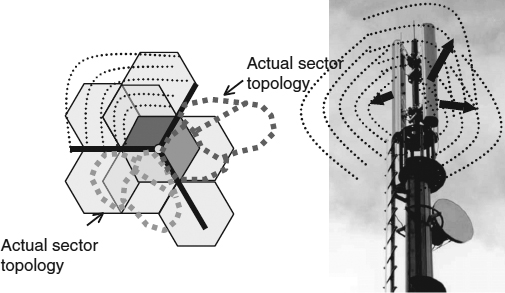12.3 THE HARSHER REALITY OF CELLULAR SYSTEMS
Our brief tour of cellular systems has shown us that despite the problem of RF transmission being susceptible to interference, we can find different ways around the problem in order to gain enough capacity for lots of users to benefit within a realistic population density. However, unlike the entirely controllable and predictable world of using cables and wires, the wireless environment still offers a degree of hostility to our attempts to beam information to our roaming mobiles, especially from having to keep up with their every move.

Figure 12.18 Cells are divided into sectors and the edges are fuzzy.
The reality of modern digital cellular communications is that we are constantly operating on the limit of the available implementation technology. Therefore, under certain conditions, wireless systems start to degrade. There are three main difficulties:
- Unpredictable terrain
- Unpredictable mobile location
- Unpredictable traffic loads
A brief examination of these challenges will highlight the difficulties in meeting our original challenge for the RF network, which was to achieve transparency, or to make it as ‘wire-like’ as possible.
The simple problem with cellular systems is with the RF waves not reaching the target directly, either from the mobile to the base station (uplink) or vice versa (downlink). RF signals do have their limitations, ...
Get Next Generation Wireless Applications: Creating Mobile Applications in a Web 2.0 and Mobile 2.0 World, 2nd Edition now with the O’Reilly learning platform.
O’Reilly members experience books, live events, courses curated by job role, and more from O’Reilly and nearly 200 top publishers.

